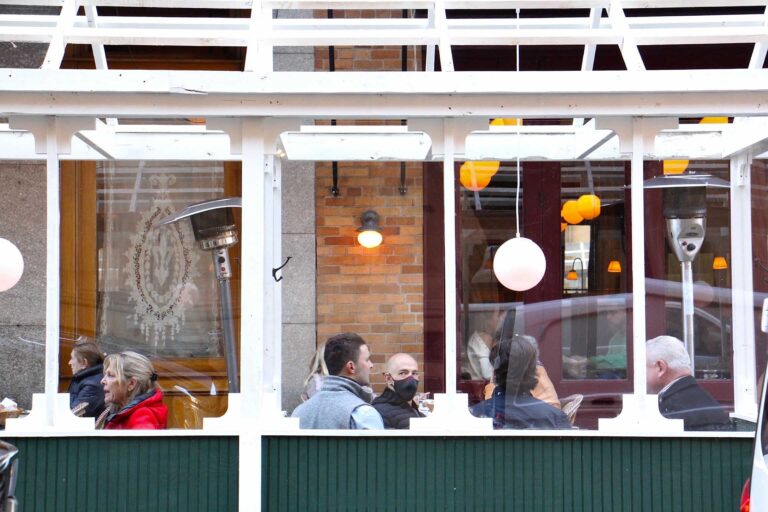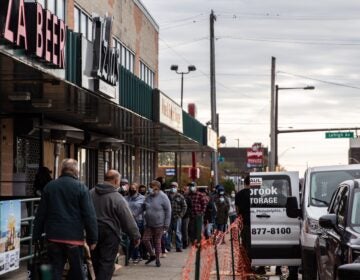Philly bans indoor gatherings, broadens restrictions amid surge in COVID-19 cases
Already-leaked restrictions become official. Starting Friday through Jan. 1, indoor dining is prohibited, gyms must close and outdoor events are limited.

Outdoor dining at Parc on Rittenhouse Square. (Emma Lee/WHYY)
Updated: 4:45 p.m.
Pennsylvania reported 4,476 new cases of the coronavirus Monday, bringing the statewide total to 269,613. The state reported 51 new fatalities, bringing the total to 9,325 deaths attributable to COVID-19.
On Monday, Philadelphia reported 2,564 additional confirmed cases, for a total of 54,607. These case counts represent the totals for three days, since new cases were last reported on Friday, Nov. 13. Eight new deaths were reported, for a total of 1,917.
City tightens restrictions again on restaurants, gyms
Philadelphia Health Commissioner Thomas Farley officially announced Monday expected new COVID-19 restrictions for the city, which will take effect Friday and continue in effect until at least Jan. 1. The measures include:
- No indoor dining at restaurants. (Farley said people gathering indoors and not wearing masks is simply too risky right now.)
- Outdoor dining at restaurants with just four people (from the same household) at a table.
- No indoor gatherings or events, public or private.
- No outdoor gatherings with more than 10% occupancy, 10 people per thousand square feet, and no food at outdoor gatherings, so people can wear masks.
- No more than five people per 1,000 square feet in stores (including employees).
- No youth, community, or school sports — and an encouragement not to just take those games to suburban counties.
- Gyms, museums, and libraries will close.
- Barbershops can stay open, but only employees and clients who are getting work done can be inside, so no one will be inside waiting.
- Religious institutions may be open with no more than 5% occupancy or five people per thousand square feet, and they are encouraged to have services online only
- Colleges and high schools will not have in-person classes.
- Child care, elementary, and middle schools can have in-person classes with COVID precautions.
At an afternoon press conference, Farley encouraged people to start following these measures now, and he said he would also encourage neighboring counties to use similar restrictions because Philadelphia shares hospitals with them.
A Montgomery County representative said earlier Monday that it has no plans to implement any new COVID-19 measures at this time but will watch the data closely.
“I know these are tough, people are going to be put out of work, some businesses may go under. We also know the consequences to health of not doing it are really bad,” Farley said.
“We’ve lasted with this virus eight months now, we can last a few months more,” he said. “A vaccine will be available in the coming months; we simply need to tide ourselves over until then.”
Farley and Philadelphia Mayor Jim Kenney said these restrictions come because it is a difficult time for the city.
“I wish none of this was necessary,” Kenney said.
The mayor pointed out that the average number of new cases reported per day last week was higher than the number of reported cases during the city’s worst week in April.
Farley noted that the number of new cases is rising exponentially, with an increase of 4% per day, which means the number of daily cases doubles about every 17 days.
Why the new limits extend to 2021
At Monday’s press conference, Health Commissioner Farley said that Philadelphia officials will be watching the number of daily cases, and that it will be a good sign if it goes down.
The earliest he would expect to see the benefits of the new measures is two weeks, Farley said, and he would be hopeful to see benefits in four weeks.
The city arrived at putting the new measures in place till next year because:
- Back in the spring, it took four weeks for the number of cases to peak after the city went on lockdown.
- The spread of the virus won’t subside until at least part of the way through winter.
- A vaccine won’t be available until January.
No one wants a lockdown like the spring’s, Farley said, noting that Europe offers a model for what to do. He said that generally countries such as Germany, France, and the U.K. saw rising case rates, so they prohibited gatherings, closed bars and restaurants and theaters and gyms, but left schools open.
“The best news out of the past couple of weeks is it appears to be working,” Farley said. “The painful scenario … is not inevitable, it can be avoided.”
Mayor Kenney noted that the city announced $30 million to help renters and small businesses last week and would also like the state legislature to allocate Philadelphia more money from the CARES Act and for Congress to pass a new stimulus package.
Farley said his biggest worry is that about half the infected people don’t know where they got it, so the virus is spreading a little bit everywhere. He said contact tracing interviews are not designed to find out where people got infected.
Neal Goldstein, assistant research professor of epidemiology at Drexel University, agreed that the key to preventing further spread of the virus is to limit gatherings, but he also said the city should put out more evidence to support its policies.
“We need to be very transparent about the evidence behind these policies. If you’re going to close indoor dining at restaurants, then public health needs to be transparent, and release the data to say these are where the case transmissions are happening,” Goldstein said. “That level of transparency is super important to build the trust in the community … public health may be losing some of that trust because people are becoming fatigued at this point.”
Aimee Palumbo, assistant professor of epidemiology and biostatistics at Temple University, said she understands the city had to do something to respond to more people getting hospitalized and the spike in the percentage of positive cases, and that it’s good the city is taking a more measured approach. However, she also said she would like to be able to see more of the data that the measures are based on.
Positivity rate is at 9.6% statewide, Pa. health officials say
The number of COVID-19 cases in Pennsylvania now stands at 269,613, with 4,476 new cases reported by state health officials Monday — a bigger increase over the past week than the state has seen since the start of the pandemic. There are 2,440 people in the hospital with COVID-19, 531 of whom are in intensive care.
The number of tests that came back positive is 9.6% statewide, also one of the largest single-week rises, according to state Health Secretary Dr. Rachel Levine. Only five counties in the state have a positivity rate below 5%. Being above the 5% percent threshold means that testing is not keeping up with transmission.
Levine said Pennsylvania is now returning an average of 45,000 tests per day, with a combination of PCR (polymerase chain reaction) tests — considered the gold standard — and rapid antigen tests. But she added that there could be more strain on labs as the entire country does more tests.
Pennsylvania’s surge in cases is in line with what health authorities and experts had expected to happen in the fall — more people gathering indoors because of colder weather.
Levine also encouraged people who get calls from contact tracers to answer the questions, especially about whether they have been to a business or large gathering two weeks before they started showing COVID-19 symptoms. She said only 16% of people asked that question during the first week of November have answered.
“This percentage continues to decrease, and more and more people are not providing this information as part of the case investigations,” Levine said. “That’s a real challenge for us.”
Levine encouraged more people to download COVID Alert PA, the exposure notification app for the state. Uptake of the app is going well, with more than 489,000 users, she said, but the goal is to get more than a million users. A Department of Health spokesperson cited a recent study (which has yet to be peer-reviewed) from researchers at Oxford University and Google that used computer models along with data from three counties in Washington state to project that if 15% of the population used exposure notification systems, infections and deaths could go down by 8% and 6%, respectively. According to 2019 census estimates, 15% of the population in Pennsylvania would be more than 1.92 million people.
The state has no plans to go back to the red-yellow-green system from the start of the pandemic, Levine said, and she encouraged businesses to limit capacity, ask people to wear masks, and practice social distancing. She also acknowledged that it would be an enormous sacrifice to have holiday gatherings only with their immediate households but that people should do it.
As New Jersey announced new restrictions on gathering size Monday, Levine said Pennsylvania is still in contact with neighboring states but does not have announcements from those discussions yet.

Get daily updates from WHYY News!
WHYY is your source for fact-based, in-depth journalism and information. As a nonprofit organization, we rely on financial support from readers like you. Please give today.





![CoronavirusPandemic_1024x512[1]](https://whyy.org/wp-content/uploads/2020/03/CoronavirusPandemic_1024x5121-300x150.jpg)

